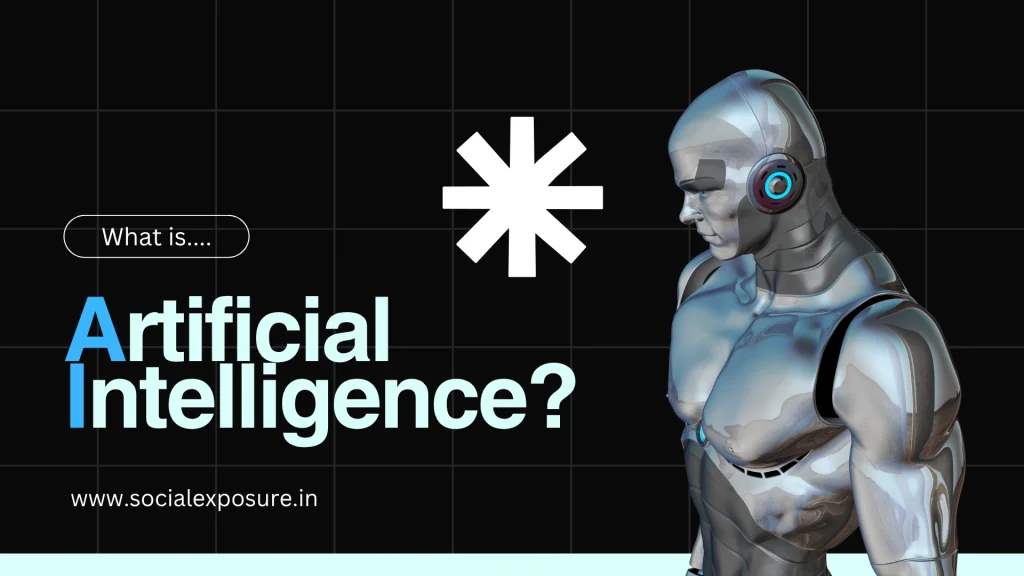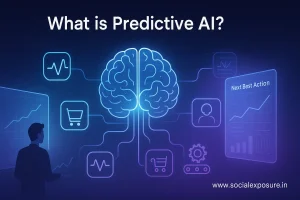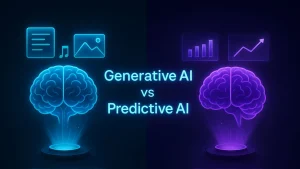If you’ve ever wondered what AI really is or why it keeps showing up in conversations, headlines, and even apps on your phone you’re not alone. The term artificial intelligence has been around for decades, but only recently has it become part of everyday life.
From voice assistants and facial recognition to language translation and shopping recommendations, AI has quietly worked its way into how we live and work.
This guide is written for people who want to understand it without getting lost in technical jargon. Whether you’re a student trying to grasp the basics, a business owner exploring new tools, a tech enthusiast keeping up with trends, or someone just curious about the buzz you’re in the right place.
The importance of AI is backed by credible data. According to Stanford’s 2025 AI Index Report, global private investment in AI hit a record $252.3 billion in 2024, with $33.9 billion going specifically to generative systems up nearly 19 percent from the year before. That tells you something the world isn’t just talking about AI, it’s putting serious money into building it and using it.
More importantly, the tools and systems built with it are reshaping how businesses make decisions, how software interacts with users, and how people solve problems.
By the time you finish this guide, you’ll not only understand what AI means, but you’ll also see why it’s being called one of the most important shifts in how the world uses technology.
What is AI?
To put it simply, AI refers to machines or systems that are designed to think and act in ways that feel human. It’s not about science fiction or robots taking control. It’s about teaching machines to learn, solve problems, and make decisions just like people do.
Picture this: when you search for a product online and instantly see recommendations that match your interest, that’s artificial intelligence working behind the scenes. It learns from your behavior, adjusts its output, and gets smarter with time. This kind of smart interaction is what makes AI technology different from traditional programming.
If you’re looking for the meaning of AI in simple terms, think of it as a way for machines to understand what’s happening around them and take action without needing step-by-step instructions. Whether it’s helping cars stay in their lane, powering voice assistants, or detecting unusual activity in your bank account, AI is designed to make systems think and respond intelligently.
According to data from AltIndex.com, global adoption of AI tools is projected to rise another 20 percent, reaching 378 million users in 2025. That includes everything from chatbots and smart assistants to advanced software that helps businesses analyze massive amounts of data in real time.
The term artificial intelligence was first introduced in the 1950s, but today it’s no longer just an academic concept. It’s part of how we live, work, and make decisions often without even realizing it. From the apps we use to the way businesses operate, AI is becoming a silent but powerful part of everyday life.
Why Does AI Matters Today?
If you’ve used a smart assistant to set a reminder, received a product suggestion online that felt just right, or interacted with a chatbot while shopping then you’ve already experienced AI in daily life. What makes this technology so valuable today is how quietly and efficiently it works behind the scenes.
The importance of AI goes far beyond convenience. In business, it helps teams automate repetitive tasks, improve customer support, and uncover insights from large volumes of data. In healthcare, it’s helping detect illnesses earlier. In education, it’s personalizing how students learn. These real-world outcomes are the reason why AI today is seen as more than just a trend.
Understanding why AI is important starts with looking at its reach. It’s shaping industries, influencing the way we work, and helping people make faster, better decisions. Social Exposure supports businesses in staying competitive by helping them understand and integrate smart technologies effectively.
As tools powered by artificial intelligence become more central to daily operations, learning how to use them isn’t just an upgrade, it’s becoming a necessity.
Real-World Uses of AI
Understanding the uses of artificial intelligence gets easier when you look at how it shows up in day-to-day situations. Whether you’re shopping, streaming, or managing money, AI in real life is already part of the experience.
Here are some practical AI use cases that most people interact with regularly:
- Customer Support Chatbots: Many companies now use AI-powered chatbots to assist customers around the clock. According to Gartner By 2027, chatbots will become the primary customer service channel for roughly a quarter of organizations.
- Recommendation Systems: Platforms like Netflix and Amazon use AI to study your preferences and suggest what you’re likely to enjoy or buy. McKinsey reports that recommendation systems drive up to 35 percent of Amazon’s total sales.
- Fraud Detection in Banking: Banks rely on artificial intelligence to monitor every transaction and spot signs of fraud at lightning speed. According to Visa’s 2019 report, its AI system analyzed 127 billion transactions across its network and helped financial institutions prevent approximately $25 billion in fraud that year
- Voice Assistants: Tools like Siri, Alexa, and Google Assistant rely on natural language processing to understand spoken commands. According to statista As of 2024, the number of active digital voice assistants worldwide reached approximately 8.4 billion and that figure is expected to rise further in the coming years
- Email Filtering and Spam Detection: AI helps email providers block malicious content and keep inboxes clean. According to Google’s official announcement on Gmail’s spam protection, Gmail blocks over 99.9 percent of spam, phishing, and malware powered by machine learning systems enhanced with TensorFlow, which currently blocks more than 100 million additional spam messages each day.
These real life applications of AI are not just futuristic ideas, they’re shaping how people live, communicate, and make decisions right now.
If you’re looking to apply these tools in a way that actually drives business results, Social Exposure helps brands turn everyday AI into real marketing advantage. Smarter campaigns, better reach, and stronger results without the guesswork.
Key Features of AI
What makes artificial intelligence different from traditional software is how it responds and improves over time. It doesn’t just follow fixed rules it can observe, adjust, and learn. These AI capabilities are what allow it to handle tasks that once needed human decision-making.
Here are some of the most important features of artificial intelligence that make it useful in daily life and business:
- Learning from Data: AI can analyze large amounts of information and recognize patterns. This ability is often called the AI learning ability, and it’s how systems like recommendation engines improve the more they’re used.
- Adapting to New Inputs: AI doesn’t need to be reprogrammed every time something changes. It can adjust its responses based on new information or behavior it observes just like a person learning from experience.
- Solving Complex Tasks: From predicting outcomes to automating routine decisions, AI can handle situations that involve many variables, even when things get complicated.
- Interacting in Natural Language: One major machine learning feature is the ability to understand and respond to human language. This makes tools like chatbots and voice assistants more intuitive to use.
- Decision-Making Support: AI helps users make smarter choices by offering insights, predictions, or recommendations based on the data it processes.
These capabilities are already shaping how industries operate. Social Exposure, recognized as the Best Digital Marketing Agency, applies these features to help businesses understand their audiences better, personalize their messaging, and achieve stronger results through intelligent automation.
What is the Goal of Artificial Intelligence?
When people ask what the goal of artificial intelligence is, the answer usually comes down to one thing: helping systems think and act in a way that improves how work gets done. AI is built to take on tasks that require attention, analysis, or repetition, and do them with speed, consistency, and scale.
The current AI objectives focus less on replicating human consciousness and more on solving real problems. Here’s what most AI systems aim to do today:
- Support decision-making: AI helps by sorting through large amounts of data to highlight trends or suggest possible actions. This is especially useful in fields like marketing, healthcare, and finance where timing and accuracy matter.
- Automate routine tasks: Repetitive work like data entry, appointment scheduling, or even customer queries can be handled efficiently by AI, freeing up human time for more meaningful work.
- Improve efficiency: AI systems are used to cut down on wasted time and effort by making processes faster and more accurate.
- Adapt to changing inputs: One of the most important goals of modern AI is to learn and respond to new data without needing constant updates or human oversight.
While these goals vary depending on the use case, the core idea remains the same: AI exists to make work simpler, decisions smarter, and systems more responsive.
Social Exposure plays a role in helping brands understand and use these AI-driven tools, making sure they serve a clear business purpose rather than becoming just another trend.
Why Do We Need AI?
If you’ve ever spent hours sorting through files, repeating the same task, or trying to make sense of data you already understand the reason behind why we need artificial intelligence.
Here’s how it helps you:
- Saves time: AI can handle repetitive tasks like organizing emails, tagging files, or analyzing reports in seconds. This means more time for you to focus on work that requires your attention.
- Improves accuracy: Unlike manual processes that can lead to errors, AI follows patterns and logic with consistency. That makes it reliable for activities like scanning invoices, checking documents, or measuring performance.
- Handles large data: AI is built to manage more data than a person could sort through manually. From predicting customer behavior to optimizing ad budgets, it helps make better choices based on what the numbers actually show.
The importance of AI in business isn’t just about speed. It’s about making sure the right decision happens at the right time, based on real information. Whether you’re managing a small team or scaling a growing company, tools powered by AI can support daily tasks and long-term goals.
If you’ve been wondering how AI helps in business and daily tasks, the answer lies in what it replaces: hours of guesswork, back-and-forth decisions, and time lost to routine steps. It fills the gap between what you know and what you need to do next with speed and clarity.
Common Misunderstandings About AI
There’s a lot of talk around AI, but not all of it reflects how it actually works. Misunderstandings can create fear, hesitation, or even false expectations. Let’s clear up some of the most common ones.
- “AI means robots”
People often assume AI means physical robots walking around and doing human jobs. In reality, most AI exists in software like search engines, customer service systems, or language tools. You’re using it when your phone suggests your next word or your map app finds the best route. - “AI replaces all jobs”
Another popular myth is that AI will leave people without work. While some tasks are being automated, most systems are built to support not replace people. In many industries, AI is making roles more focused by removing repetitive work. - “AI can think like a human”
Despite what movies might suggest, current AI doesn’t have feelings, consciousness, or intent. It follows data patterns and performs tasks within those limits. That’s an important distinction when separating AI myths vs facts. - “AI works like magic”
One of the biggest misconceptions about AI is that it can do anything with just a command. In truth, AI needs the right data, clear input, and constant updates to perform well. It’s powerful, but not perfect.
Understanding what AI is not is just as important as knowing what it can do. That clarity helps you make smarter choices when working with or investing in AI tools.
Conclusion
Understanding AI doesn’t require a background in coding or engineering. As we’ve explored, artificial intelligence is already woven into the tools and services many people use every day. It learns from data, adapts to new situations, and helps people work smarter not harder.
Whether it’s managing tasks, analyzing patterns, or offering real-time decisions, the importance of AI today is clear. It’s shaping how businesses grow, how users interact with technology, and how everyday problems are being solved more efficiently.
If you’re just starting out or thinking about applying AI to your own work, the best first step is to stay informed. Not with buzzwords or complicated theories, but with explanations that actually make sense.
Social Exposure is here to offer that clarity. As a reliable partner, we help simplify complex tech like AI, giving you the tools and insights to use it in ways that feel natural and valuable for your business or personal goals.
Frequently Asked Questions
What is AI in simple words?
AI, or artificial intelligence, refers to machines designed to perform tasks that typically require human thinking. These tasks include learning from data, solving problems, and making decisions based on patterns.
How is AI used in daily life?
You experience AI daily uses through navigation apps, smart assistants, email filters, and product recommendations. It helps personalize your experience, automate responses, and streamline basic activities across devices and platforms.
What are the benefits of using AI in business?
AI in business improves efficiency by handling repetitive tasks, providing data-driven insights, and supporting faster decisions. It helps reduce errors, save time, and personalize customer engagement at scale.
Is AI the same as machine learning?
Not exactly. Machine learning is a subset of AI. While AI covers a broad range of intelligent systems, machine learning focuses on systems that learn and improve from data without being explicitly programmed.
Why is AI becoming popular now?
AI is growing due to more available data, better computing power, and increasing demand for automation. Tools built with artificial intelligence are now more accessible to everyday users and businesses.
Can small businesses use AI too?
Yes. Many cloud tools and services now offer uses of artificial intelligence that fit small budgets. From chatbots to analytics platforms, AI is no longer limited to large enterprises.
Is AI dangerous or helpful?
Like any tool, AI depends on how it’s used. While it raises important questions about fairness and privacy, most current applications are designed to assist, not harm. Responsible use is key.
Who is using AI today?
Businesses, educators, governments, hospitals, and even individuals use AI. It powers customer support, recommendation systems, fraud detection, and more. The spread of AI spans almost every industry.
Does AI mean automation?
Automation is one part of AI, but not the whole picture. While some systems automate tasks, others help people make better decisions or enhance tools they already use.
Can AI make decisions on its own?
AI makes choices based on data and pre-set rules. It doesn’t have feelings or intent, but it can provide helpful recommendations and carry out tasks when programmed to do so.






